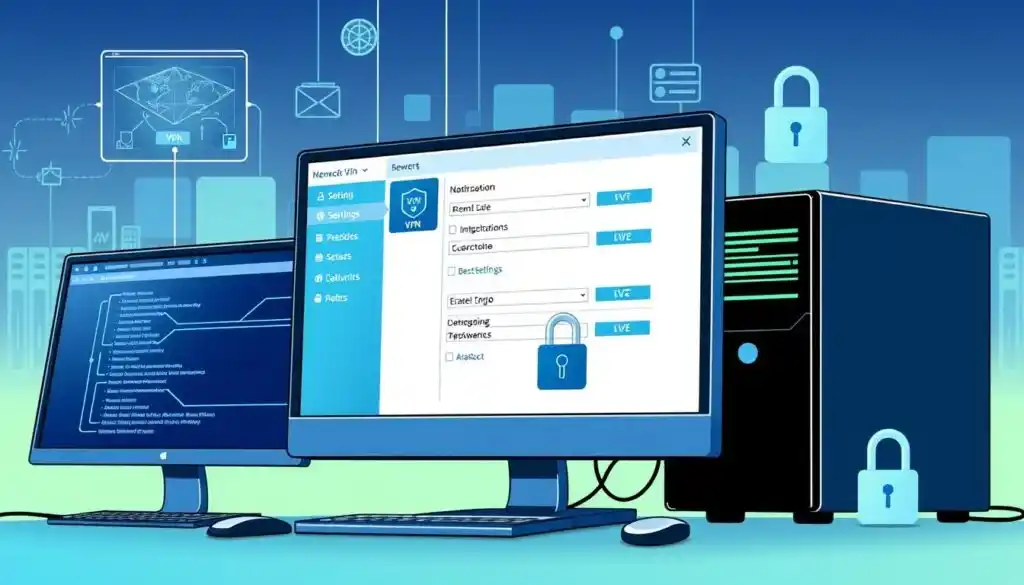Last updated on December 15th, 2024 at 07:28 pm
In today’s world, having a secure internet connection is crucial. worker搭建ikev2 is a great way to keep your online activities safe. This guide will show you how to set up worker搭建ikev2. It’s a powerful IKEv2 VPN protocol that makes your online experience smooth and secure.

If you want to keep your remote work safe, protect your data, or get around online blocks, this guide is for you. It will teach you how to set up a strong IKEv2 VPN using a worker. We’ll go over everything from the basics of IKEv2 to how to set it up. You’ll learn how to make a secure and reliable connection.
Key Takeaways
- Comprehensive guide to setting up worker搭建ikev2 VPN
- Covers IKEv2 protocol fundamentals, security features, and architecture
- Provides step-by-step instructions for system requirements and configuration
- Ensures a reliable and secure connection for remote work, data protection, and more
- Helps users navigate the worker platform for IKEv2 VPN setup
Understanding IKEv2 Protocol Fundamentals
The IKEv2 (Internet Key Exchange version 2) protocol is a key security benchmark for VPN connections. It guarantees that data remains protected and secure. This positions it as a leading option for VPNs currently.
Key Benefits of IKEv2 Implementation
IKEv2 offers many benefits for VPNs:
- It’s reliable, fast, and supports mobility well. This means users stay connected securely, even when moving between networks.
- Its encryption is strong, protecting data from unauthorized access or eavesdropping.
- The protocol’s architecture supports various authentication methods. It also allows secure tunnels between different endpoints, making communication safe across different environments.
Security Features and Protocols
IKEv2’s security is based on strong encryption and authentication. It uses:
- Encryption algorithms like AES, Chacha20-Poly1305, and ECC to keep data confidential.
- Cryptographic hashing algorithms such as SHA-256 and SHA-384 are used to maintain data integrity.
- Advanced authentication methods, such as pre-shared keys, digital certificates, and EAP-TLS, to verify identities.
Protocol Architecture Overview
The IKEv2 protocol architecture is designed for secure VPN connections. It has two main phases:
- Phase 1: Negotiation and authentication of VPN endpoints.
- Phase 2: Establishment of secure data channels for information transfer.
This structured approach sets up VPN connections securely and efficiently. It enables dependable communication between the client and server.
Prerequisites for worker搭建ikev2 Setup
Before starting the worker搭建ikev2 setup, make sure you have everything you need. This part covers the main VPN setup requirements, worker configuration prerequisites, and system preparation steps. These will help you set up without any issues.
First, you’ll need a few things:
- A compatible operating system, like Windows, macOS, or Linux, with the right version and settings.
- A stable internet connection with enough speed for VPN traffic.
- Admin or root access to your system, as some steps need it.
- Basic knowledge of command-line and system admin tasks.
Also, make sure your system preparation is done. This includes:
- Check if your system has all the needed software packages and dependencies.
- Confirming no other VPN or network settings will mess with your worker搭建ikev2 setup.
- Backing up important data or settings that might get changed during setup.
By following these VPN setup requirements, worker configuration prerequisites, and system preparation steps, you’re ready for a smooth worker搭建ikev2 setup. Next, we’ll look at the system needs and configuration details.
System Requirements and Configuration
To set up a successful worker搭建ikev2 system, you need to check your hardware, software, and network. This section will guide you through the key requirements. It helps you see if your setup is ready or if you need to make changes.
Hardware Specifications
The VPN hardware requirements for worker搭建ikev2 include:
- Processor: Minimum 2.0 GHz dual-core CPU
- RAM: At least 4 GB of memory
- Storage: 20 GB or more of available disk space
- Network Interface: Gigabit Ethernet or higher
Software Dependencies
For the worker搭建ikev2 setup, you also need certain software:
- Operating System: Linux distribution (e.g., Ubuntu 20.04 LTS, CentOS 7, or Debian 10)
- Networking Tools: OpenVPN, iptables, and iproute2
- Cryptographic Libraries: OpenSSL and libsodium
- Scripting Language: Bash or Python
Network Requirements
For a smooth worker搭建ikev2 network setup, consider these network needs:
| Requirement | Specification |
|---|---|
| IP Address | Static or dynamic public IP address |
| Port Forwarding | Configured to allow incoming VPN connections |
| Firewall | Configured to permit VPN traffic on the necessary ports |
| DNS | Accessible and properly configured DNS servers |
By meeting these VPN hardware requirements, software dependencies, and network configuration specs, you’re on the right path. You’ll have a successful worker搭建ikev2 setup.
Initial Server Configuration
Starting the worker搭建ikev2 setup needs careful server preparation. This first step is key for a smooth and safe VPN server setup. We’ll look at the main steps to make your server run well and prepare for the next steps.
Operating System Optimization
First, make sure your server’s operating system is current and running well. Update system packages, turn on security settings, and set up network options. Doing this right makes your server stable and ready for the VPN server.
Firewall Configuration
Setting up your server’s firewall is very important. Make the right port forwarding rules, open needed ports, and protect your VPN server from unwanted access. This step boosts your VPN server’s security.
Resource Allocation
Check your server’s hardware like CPU, memory, and storage. Make sure you have enough to avoid slowdowns and ensure a good user experience. This helps create a strong and efficient VPN server setup.
By focusing on these early steps, you set a strong base for the worker搭建ikev2 setup. This careful work will help as you move on to more steps. It will lead to a strong and safe VPN server solution.

Installing Required Dependencies
To set up a worker搭建ikev2 VPN, you need to install several key dependencies. These ensure your VPN works smoothly and help you fix any setup problems.
Package Installation Steps
First, you’ll need to install some packages:
- Choose a VPN client like OpenVPN or WireGuard, based on your system and preferences.
- Make sure your package manager is up to date. For Ubuntu, use apt-get. For CentOS, use yum.
- Install needed libraries and dependencies. This includes libssl-dev, libpam-dev, and libnss3-dev.
Dependency Verification Process
After installing packages, check if everything is working right. Here’s how:
- Use the right command to check your VPN client’s version (e.g., openvpn –version or wg version).
- Make sure libraries are installed and updated with apt-get/yum list installed | grep [library_name].
- Attempt to connect to the server to verify your VPN client.
Troubleshooting Common Installation Issues
Even with careful planning, you might run into installation problems. Here are some tips to help:
| Issue | Potential Cause | Resolution |
|---|---|---|
| Package installation fails | Outdated package repository or missing dependencies | Update the package repository and install any missing dependencies |
| VPN client software not functioning properly | Incorrect configuration or missing required files | Review the configuration files and ensure all necessary files are present |
| Connectivity issues | Firewall or network restrictions | Check your firewall settings and network configuration to ensure VPN traffic is allowed |
By following these steps and fixing any problems, you’ll successfully set up your worker搭建ikev2 VPN.
Certificate Generation and Management
Setting up a secure VPN needs the right SSL certificates. These certificates are key to keeping your data safe. We’ll show you how to create and manage these important security tools.
Generating SSL Certificates
To start, you need to make SSL certificates for your VPN. You can use tools like self-signed certificates or get them from trusted Certificate Authorities (CAs). Free SSL certificates from Let’s Encrypt are also an option.
- Choose the right certificate type for your VPN’s security needs.
- Generate the SSL certificates by creating a Certificate Signing Request (CSR) and getting the signed certificate.
- Make sure the certificates fit well with your VPN setup.
Implementing SSL Certificates
After getting your SSL certificates, you need to add them to your VPN. This might mean changing configuration files or server settings. You must ensure the certificates work right with your VPN.
| Certificate Type | Pros | Cons |
|---|---|---|
| Self-Signed Certificates | Easy to make No cost from third parties | Not trusted by default Need manual setup |
| CA-Signed Certificates | Trusted by default More secure | Need third-party certification Cost more |
| Let’s Encrypt Certificates | Free and easy to get Renews automatically | May have usage limits Needs regular renewal |
It’s crucial to keep your SSL certificates current and well-managed. This means renewing them regularly and making sure they work well with your VPN. This keeps your VPN secure.

By following these steps for SSL certificate creation and management, you can keep your VPN safe. This protects your data and keeps your VPN secure.
Worker Configuration Process
Setting up the worker for IKEv2 is key. This guide will help you set up the config file and tweak settings for your VPN. It’s all about making your VPN just right for you.
Configuration File Setup
First, you need to make a config file for your IKEv2 VPN. It should have the VPN server address, your login info, and other details. Make sure it’s set up right to avoid any issues.
Parameter Customization
After setting up the file, you can start tweaking the settings. This includes things like encryption and how keys are exchanged. It’s all about making your VPN fast and secure.
By fine-tuning your worker, you can make sure your IKEv2 VPN works great. It will be fast, secure, and just what you need.
| Configuration Parameter | Description | Recommended Setting |
|---|---|---|
| VPN Server Address | The IP address or domain name of the VPN server | vpn.example.com |
| Authentication Method | The method used to authenticate users, such as username and password or pre-shared key | Username and Password |
| Encryption Algorithm | The algorithm used to encrypt data transmitted over the VPN | AES-256-GCM |
| Key Exchange Method | The method used to exchange encryption keys between the client and server | Diffie-Hellman Group 14 |
Keep in mind, your settings might need to change based on your network and security needs. Always double-check and test your setup for the best results.
Security Implementation Measures
Keeping your worker搭建ikev2 setup safe is key to protecting sensitive data. It ensures a reliable VPN connection. At the core, using strong encryption like AES and ECDSA is vital. These methods keep your data safe and sound.
Access controls are also crucial for your VPN’s security. Strong authentication, like multi-factor and user permissions, helps block unauthorized access. This keeps your network safe from threats.
Following industry-standard security practices is also important. This means updating software, using secure channels, and watching for suspicious activities. A proactive security approach keeps your setup safe and reliable for your organization.
FAQ
What is the IKEv2 protocol, and what are its key benefits?
IKEv2 is a secure VPN protocol. It offers strong encryption and reliable connections. It also supports seamless mobility, making it great for VPN connections.
What are the system requirements for setting up worker搭建ikev2?
To set up worker搭建ikev2, you need a compatible server. It should have enough CPU, RAM, and storage. You also need the right operating system and packages.
How do I configure the server for worker搭建ikev2?
First, set up the server environment. Then, install the needed dependencies and optimize for performance. This includes installing packages and troubleshooting issues.
What is the process for generating and managing SSL certificates for worker搭建ikev2?
SSL certificates are key for secure VPN connections. You must create and deploy them on the server.. Regularly manage and renew them to keep connections secure.
How do I customize the worker configuration for my specific needs?
Customize the worker configuration by setting up files and adjusting parameters. Tailor the VPN to your needs by changing encryption and access controls.
What security measures are implemented in worker搭建ikev2?
Worker搭建ikev2 uses strong security measures. It employs strong encryption and access controls. These practices protect your data and connections.
conclusion
setting up the worker搭建ikev2 VPN is an essential step toward ensuring a secure and reliable online experience. By following the comprehensive guide outlined in this article, you can effectively configure your IKEv2 VPN to safeguard your data, facilitate remote work, and maintain privacy while navigating the internet. The process involves key steps such as understanding the IKEv2 protocol, meeting system requirements, optimizing server configurations, installing necessary dependencies, and implementing strong security measures. With a properly configured worker搭建ikev2 setup, you will benefit from a robust, fast, and secure connection that is essential for today’s digital landscape. Whether you’re protecting sensitive information, accessing blocked content, or ensuring a seamless remote work environment, this guide equips you with the tools needed for success.






